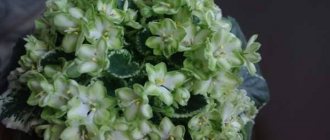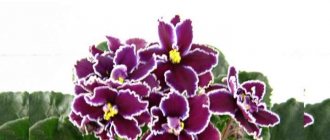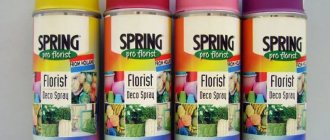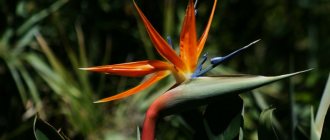Flowers look elegant, like children at a school assembly or like a bride at a wedding.
Among violets with white flowers, the Wedding Bouquet variety is popular.
Our material for today is about how to properly care for it, form a beautiful rosette and propagate it.
What does a violet look like Wedding Bouquet
Violet Wedding bouquet is an incredibly spectacular flower. It was bred by K. Morev, a famous breeder. This variety gave rise to a sport called Our Wedding, as well as a seedling - violet Bride's Bouquet.
Violet Wedding Bouquet
A seedling may be practically indistinguishable from a varietal flower in appearance, but it would not be correct to compare them. Violet Bride, unlike Wedding Bouquet, has unstable varietal characteristics. At the moment, two varieties of this variety are known. They are distinguished by the shape of their leaves.
Attention! According to the description, the variety with pointed leaves is less capricious and is more fertile.
The flower got its name thanks to its large white flowers, similar to a bridal bouquet. The diameter of the flowers ranges from 5 to 6.5 centimeters. The flowers themselves look like double stars with a corrugated edge, white on top and silver on the back. The petal has a green border, which disappears over time.
If such a border appears again in the middle of flowering, then the air temperature in the room is too low. It will be enough to raise the air temperature so that the flowers become perfectly white again. When the bouquet blooms completely, it looks like an airy snow-white cloud above a green rosette.
History of the variety
The Wedding Bouquet variety appeared thanks to the breeding work of Konstantin Morev.
Konstantin Lvovich Morev is a student of the world-famous Russian breeder Boris Mikhailovich Makuni. Breeding work is carried out using the latest technologies that appeared in the 21st century.
Konstantin Morev's varieties are not inferior to foreign ones. He pays special attention to multi-colored plants with clear strokes of prominent shades.
Master Saintpaulias are characterized by a compact rosette of leaves, unusual colors of petals, lush, long-lasting flowers in a cluster arrangement.
Based on the Wedding Bouquet variety, breeder L. Pak developed the “Our Wedding” variety, which is a sport with a chimeric coloring.
Features of violet care Wedding bouquet
Homemade bullfight violet - description of the flower
This variety of violet is very easy to care for. It does not require special conditions, you just need to follow a few simple rules.
In summer, the air temperature should not be higher than 24 degrees. Otherwise, the appearance of the flowers will change. They will look simpler and lose their shimmer and shape.
In winter, the temperature should not fall below 18 degrees. Otherwise, the plant will begin to freeze, and if watered abundantly, it will rot. A wedding bouquet loves light, but the flower must be protected from direct sunlight. You should not place it on a window facing south, because delicate flower leaves can get burned, and the roots can overheat.
Burn on the leaves
If all the windows in the house face south, then the flower must be shaded. If there is insufficient lighting, additional lighting will be necessary. It is best to install the flower on east and west windows.
Water for irrigation must first be settled and then frozen so that it becomes soft. Before use, the water is defrosted and warmed to room temperature. Too cold water has a bad effect on the root system of the plant.
Important! You should water your violet no more than once or twice a week to prevent overwatering.
During the period of plant growth and development, when a rosette begins to form, it is necessary to provide the flower with fertilizers containing nitrogen. As soon as the buds form, you need to exclude nitrogen and include phosphorus and potassium in the bait. There is no need to fertilize more than once every 2 weeks. If the flower is sick, you should wait a while with feeding.
Botanical description
Uzumbara violet (or Saintpaulia) “Bride's Bouquet” was bred by Russian breeder Konstantin Morev. It is rightly considered one of the best varieties in his collection. Morev’s “handwriting” is easily recognizable among violet growers - all his creations have compact symmetrical rosettes and lush, large star-shaped flowers with strongly corrugated edges, making up dense “caps”.
“Bride’s bouquet” or, as it is also called, “Wedding bouquet” was no exception. The variety is distinguished by snow-white multi-layered terry-type “stars” with a slight bluish tint in the center and a soft green border. The color of the violet depends on the degree of opening of the buds and the air temperature.
At the beginning of flowering, and this usually happens in the spring, when the apartments are still cool, a pronounced lettuce border is noticeable on the petals. However, as the buds bloom and the house gets warmer, the green tint becomes less common. Until, finally, the petals acquire an even white tone.
To maintain a spectacular border, it is recommended to maintain the room temperature no higher than 20 - 24ºС.
The reverse side of the petals is painted in a rare silver-blue hue, creating a light hazy effect. This feature immediately distinguishes Morev’s “Bride’s Bouquet” from analogues bred by other breeders. Another characteristic difference is the strong peduncles, “hovering” above the foliage and giving the plant airiness.
The “Wedding Bouquet” impresses with the size of its elegant, but surprisingly voluminous “cap”. The diameter of the flowers in it ranges from 4 to 6.5 cm. The result is a spectacular contrast with a neat, small rosette consisting of rich green leaves with a loosely quilted texture.
Features of the variety
“Wedding” Saintpaulia is one of the most beautifully flowering varieties. Terry stars open very quickly and continue to please the eye for 2 – 3 weeks. At the same time, the plant constantly produces new buds, larger than their predecessors. Usually a violet has 5 peduncles, each of which has at least 4 luxurious terry “stars”.
A fully blossomed Saintpaulia looks like a round bouquet with a loose, loose structure, fully justifying its name. Violet growers unanimously recognize it as the best among white-flowered standards. In addition to its unique beauty, the good adaptability of the plant, which is comfortable in the same conditions as its owners, is valued.
Having noticed that Saintpaulia “Bride’s Bouquet” is sick, drying out or, on the contrary, rotting, you need to pay attention to the microclimate in the house - it is also unsafe for human health. The snow-white beauty begins to bloom already 8–10 months after cuttings. Those who encounter this variety for the first time are surprised by the rapid appearance of the first buds, as well as their splendor and large number
Flowering periods are repeated every 1 to 3 months, depending on the conditions created. Like other representatives of the Gesneriev family, the Morev violet does not tolerate heat well. At high temperatures, it may not bloom at all, or instead of double buds it may produce smaller simple ones
Those who encounter this variety for the first time are surprised by the rapid appearance of the first buds, as well as by their splendor and large number. Flowering periods are repeated every 1 to 3 months, depending on the conditions created. Like other representatives of the Gesneriev family, the Morev violet does not tolerate heat well. At high temperatures, it may not bloom at all, or instead of double buds it may produce smaller simple ones
The snow-white beauty begins to bloom already 8–10 months after cuttings. Those who encounter this variety for the first time are surprised by the rapid appearance of the first buds, as well as by their splendor and large number. Flowering periods are repeated every 1 to 3 months, depending on the conditions created. Like other representatives of the Gesneriev family, the Morev violet does not tolerate heat well. At high temperatures, it may not bloom at all, or instead of double buds it may produce smaller simple ones.
Saintpaulia shoots abundantly, which can be beneficial for flower growers. When propagated by daughter rosettes, varietal characteristics are better preserved. However, untimely removal of stepsons reduces the abundance and quality of flowering.
There are 2 subspecies of “Wedding Bouquet” - with rounded and pointed leaves. In the second case we are talking about sports (varietal mutation)
Violets with sharp leaves are stronger and more prolific than their counterparts; it is recommended that novice gardeners pay attention to them
When and how does it bloom
Description of the flower variety violet Duchess Lux
On average, eight to ten months pass from cutting to flowering. Violet blooms from one to three months. Flowers replace each other quite quickly. Some fade, while others bloom. Therefore, we can say that the Wedding Bouquet violet blooms almost all year round.
The rosette itself is very compact, with four to five buds on each peduncle. The leaves are green, rounded. Flowers are always dense, with a large number of petals. Perfectly shaped rosette.
Display of life phases
Violet rosemary
The variety is characterized by a standard course of basic life processes, which is a big advantage when beginning Saintpaulia lovers choose violets for their collections - you can quite simply build care regimens according to classical schemes.
Specificity of room development
Varietal violet is not picky and is ideal for any collection due to its complex of positive qualities:
- Knows how to independently fold an ideal rosette, the decorative effect of which is not affected by almost any harmful factors;
- It features the most compact dimensions - a big plus for saving space;
- Does not require a specific microclimate;
- Gives voluminous flowering in a cap type with large, quickly opening flowers and a long period of time;
- Easy to care for and reproduce;
- Quickly restores its shape after mandatory transplants;
- Gorgeous at any stage of development.
ADVICE! The variety requires careful temperature control. This is due to the peculiarity of the violet - the appearance on the contours of the petals in cool conditions of a greenish edge of insignificant width, which dissolves in white as the temperature rises.
Among the minor negative features of the variety are:
- Explicit heat intolerance - violet flowers can become simple in structure;
- The formation of a large number of stepsons that disrupt the decorative effect and interfere with the growth of violets;
- Yellowing of the leaves of the lower tier with low light and lack of nutrition;
- Formation of boats from leaves in large amounts of light;
- Formation of weak peduncles during the first flowering.
Education of an adult specimen
The onset of the first flowering and, at the same time, the maturation of the violet occurs in a standard time frame: approximately eight to ten months after the formation of the rudiments of the children on the leaf cuttings.
When a young violet develops from a planted stepson, the plant will need a little less time to mature, since it will only gain strength and form buds.
Peculiarity of reproduction
The reproduction process of varietal violets is almost no different from the classics of most varieties of Saintpaulia - the same patterns, timing and only two possible vegetative methods:
- It is possible to get a new bush by separating the overgrown stepsons from an adult Saintpaulia, which the variety produces in huge quantities, and rooting them in due time;
- A young specimen can be formed by getting a baby on a leafy, specially prepared cutting and rooting it in its own flowerpot.
IMPORTANT! Propagation of violets by seeds threatens the complete loss of the characteristic characteristics of the variety. With mandatory rejuvenation of adult violets, their varietal characteristics do not disappear
With the obligatory rejuvenation of adult violets, its varietal characteristics do not disappear.
Effect of temperature on flowers
Violet at temperatures optimal for most Saintpaulia varieties:
- Blooms a lot, in large volumes;
- And has snow-white corollas.
When flowering begins in somewhat cool conditions, as is typical for early spring bud formation, the edges of the petals may have a greenish edge.
Elevated temperatures contribute to the complete disappearance of the green tonality in the color of the corollas.
CAREFULLY! Sudden changes in temperature and drafts can cause the buds to completely fall off and the flowers to begin to open. You should definitely protect your violet from these unfavorable factors!
The structure of peduncle branches
Violet in the first flowering phase can form slightly weakened peduncles, which, as the bush matures:
- They acquire a strong structure;
- And they are able to support large hats in an ideal upright position.
Flowering type model
From the very beginning, Saintpaulia tries to correspond to the varietal description of flowering and form at first small, and then very powerful caps of large-diameter flowers. To help the plant in this process, it is better to try to remove the first buds before they open.
Lifespan of an individual flower
Saintpaulia blooms for up to three weeks.
Compared to other white-flowered varieties, violet retains its decorative bloom for a long time, and each individual flower can live up to three weeks.
How to propagate violets Wedding bouquet
Violet Black Pearl - description of a home flower
There are several options for propagating Wedding Bouquet violets. One of them is using cuttings. You need to use the leaves of the middle row of the rosette. You can immediately place the leaf cuttings in prepared loose soil, or you can first put them in water and wait until the roots appear.
Rooting cuttings in water
Within a month, babies appear on the cuttings. You shouldn’t separate them and replant them right away. You need to wait until the leaves become 3-4 centimeters in diameter.
To protect the young rosette, it is recommended to cover it with a transparent cap during rooting. After new leaves appear, the cap can be removed.
Another method of propagation is growing from a stepson. Violet Wedding flower often throws out daughter rosettes, which must be removed immediately. There should only be one outlet in the pot. If both mother and stepson grow in the same pot, the flower will not bloom. The stepson is carefully separated from the flower and transplanted into special soil.
Growing from seeds
You can also grow violets from seeds. To do this, the seeds must first be prepared.
First, they are mixed one to one with crushed charcoal, and then, in the same proportions, with sand. In this case, the mixture must be shaken thoroughly.
For planting seeds, special phyto-cassettes with a lid are best suited. First, drainage is poured into the container, then sand, sphagnum moss and finally soil. Next, the seeds are planted on moist, pre-prepared soil. Cover with a lid and place in a warm place, out of direct sunlight.
Collect or buy?
The problem with a bouquet of forest and wildflowers for city residents is their low availability.
After all, it is necessary to collect plants no later than the evening of the previous day, after the dew has settled. Or better yet, early in the morning, at dawn. It is a rare bride who will agree to put aside preparations for the ceremony and start personally collecting flowers. Interesting: Who should buy the bride's bouquet?
Another nuance - field, meadow and forest plants are capricious and quickly wither. Immediately after collection, they must be divided by type, wrapped in a wet cloth or placed in water - separately. It is better to arrange a bouquet with a floral sponge and a special preservative and nourishing liquid, which is also not easy.
If you still plan to collect flowers yourself, you should:
- do this outside the city, away from roads and enterprises, away from livestock grazing areas;
- get to the collection point by car (other fastest possible transport), taking with you containers for transportation;
- cut plants with a knife, wearing gloves, immediately separating them by type;
- immediately after collection, pack different types into separate containers, you can wrap them in a wet cloth;
- At home, until the bouquet is arranged, store the collected plants in a cool, dark place.
Important: dried flowers and ears of corn do not need water! They should be folded separately and protected from moisture.
More expensive compositions (10-35 thousand rubles) usually include large quantities of garden and exotic plants, have considerable dimensions and expensive packaging.
What’s convenient is that such bouquets are already completely ready for use, will look fresh all day and can be delivered right when the bride leaves the house.
Transplantation after purchase and during reproduction
At the first transplant and up to three years, a violet with part of the old soil is placed in a new pot. First, drainage is placed at the bottom of the pot, which should fill it by a third. Next, the flower is carefully installed and soil is added. When the violet is three years old, replanting is performed with a complete replacement of the soil in the pot.
Important! On the day of transplantation, the plant does not need to be watered, and after the first watering, you need to add a little more soil around the violet trunk.
It is necessary to renew the soil and change the pot to a larger one when replanting the Wedding Bouquet every spring. There are now quite a few types and brands of ready-made soil for violets sold in stores. It is quite suitable for transplantation.
However, if you have time and desire, you can prepare the mixture yourself. To do this you will need:
- five parts of leaf or turf soil;
- three parts peat;
- one part sand.
Verniculite (10% of the total volume), ash and sphagnum moss are also added here.
Gradually increasing the size of the pot by 1 centimeter when replanting, you need to ultimately settle on a pot with a diameter of 11 centimeters. No further enlargement of the pot is required. Ideally, the rosette of a flower should be three times larger than the diameter of the pot for the flower to feel comfortable.
Before transplanting, you need to carefully examine the plant. If upon inspection dry or limp leaves, flowers and rotten roots are found, they must be removed. It is better to make all cuts with a sharp knife. Next, you need to crush a couple of tablets of regular activated carbon into powder and treat all the sections with it. If after transplantation, the leaves of the plant do not touch the ground, but are located almost at the same level with it, then everything is done correctly.
Features of composing compositions from Saintpaulia
A huge variety of violets (Saintpaulias) are widely represented on the flower market. This allows you to create new design ideas. Look at the photo below - how beautiful and delicate this small bouquet of the first spring violets is.
Bouquet of spring violets.
When composing an airy bouquet of violets alone or in combination with other flowers, florists rely on some features of creating a composition:
- The rounded composition is made using a special technique, in the form of a spiral. This shape is popular among brides;
- the flowers are chosen correctly. Each bud favorably represents the other, while itself being an important component;
- The central inflorescences in the bouquet are more expressive and brighter. Ornamental plants serve as a backdrop that conveys overall beauty;
- individual work with the client. When creating an original idea, the age of the future owner and the event dedicated to the congratulations are taken into account.
Possible problems in growing
If you do not follow simple rules for caring for a Wedding Bouquet violet, you can expose the plant to many diseases.
Note! The flower is difficult to tolerate various types of diseases. You need to carefully monitor changes in the growth, development and appearance of the violet. Then you can notice the problem in time and have time to save the flower.
The main causes of Wedding Bouquet disease are excessive watering and non-compliance with temperature conditions. Failure to do so can lead to the development of fungal and bacterial diseases such as:
- late blight,
- fusarium,
- gray rot,
- rust,
- powdery mildew.
Gray rot
You can save a flower only if you immediately recognize the disease. The sick flower needs to be replanted urgently. Trim the affected leaves and roots, and sprinkle the cut areas with charcoal, having previously crushed it.
In addition to diseases, violets can be attacked by pests:
- scale insects,
- aphid,
- whiteflies,
- nematodes,
- scale insects,
- mites.
Note! To control pests, once a week you need to treat the leaves and soil with insecticides (Aktara, Fitoverm, Alatar, etc.). You need to repeat the procedure 3 times.
To summarize, it is worth noting that the Wedding Bouquet violet, which was developed by K. Morev, is suitable even for those who are very far from floriculture. It does not require special care, and if simple rules are followed, it can delight others with beautiful snow-white flowers almost all year round.
Reviews
Serafima Andreevna. “ I have been growing the magnificent variety of violets “Wedding Bouquet” for a long time, and I decided to share my observations. She has to be fed more often than others because
abundance
flowering, for it it is necessary to maintain a balance of illumination - when there is overexposure, the leaves turn into shuttles, when there is a lack of light, the lower tier of leaves turn yellow.
The presented variety is very popular with many gardeners.
The violet shoots up strongly, the first flowering may have weak peduncles, and in the heat the green border melts. All this must be taken into account, only then can you get a spectacular plant!”











